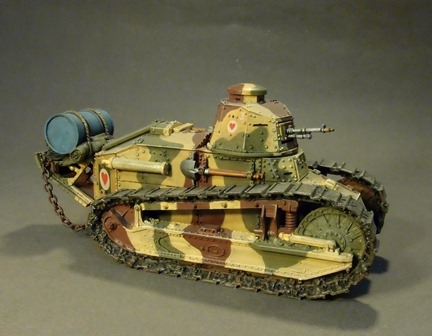
THE GREAT WAR 1914-1918
THE AMERICAN EXPEDITIONARY FORCES
GWUS-07H
Renault Ft, Hotchkiss 8mm machine gun
2nd Platoon, 1st Company,
344th Tank Battalion
304th Tank Brigade Verdun 1918
(6pcs)
US$178
The Second World War saw Dwight D. Eisenhower and George S. Patton,
Jr. accomplish their greatest deeds as soldiers and achieve lasting fame
for the role they played in bringing about the defeat of Nazi Germany.
Less well known is their service in the First World War,
when both men were involved in the birth of a new form
of warfare destined to revolutionize the battlefield and change the way wars were fought.
As officers in the United States Army's fledging Tank Corps,
they helped develop the technology of tracked armored fighting vehicles
as well as the doctrine that would later govern their use;
and, in so doing, they also helped lay the groundwork for future victories in
a conflict where the tank would come into its own as a weapon of decisions.
The AEF Tank Corps was first committed to action in the offensive aimed
at eliminating the Saint-Mihiel salient in September 1918.
The operation was conducted by the US First Army,
organized into the I, IV, and V Corps;. Patton, working with I Corps,
attacked with two battalions of the 304th Tank Brigade,
which was equipped with 144 Renaults obtained from the French.
In support of the Americans were two groupments of Schneider and St. Chamond
heavy tanks weighing 14.9 and 25.3 tons, respectively.
These were manned by French crews.
In all, the First Army deployed 419 tanks,
a figure that includes three French-crewed battalion-sized
formations of Renaults and two additional company-sized
elements of heavy tanks used in support of IV Corps.
In the St. Mihiel Offensive Patton learned that he couldn't
count on army motorization to keep his armored units supplied with fuel.
In the Meuse-Argonne campaign,
therefore, he ordered his tank crews to strap fuel drums to the back of their machines.
This entailed the obvious risk that a drum might be hit by shells or shrapnel,
causing a fiery explosion which would incinerate the crewmen inside.
Patton was well aware of the potential for disaster and,
quite characteristically, ignored it.
He felt that the loss of a few tanks and their crews
to shellfire was preferable to the loss of many to a lack of fuel.
Even so, he ordered that the drums be loosely tied
to the tanks with ropes, the idea being that a fire would burn through
the ropes and cause the drums to fall to the ground before exploding

We now accept PAYPAL,
to purchase your figures please send your order by e-mail to
inquiry@johnjenkinsdesigns.com
after checking that everything is available,
you will be billed via PAYPAL.
your order will be shipped on confirmation of payment.
worldwide airmail 12%
(minimum postage us$10)
JOHN JENKINS DESIGNS
UNIT 6E, TOWER 2,
KING LEY INDUSTRIAL BUILDING,
33-35 YIP KAN STREET,
WONG CHUK HANG,
HONG KONG
Tel: 852 9041 9065
